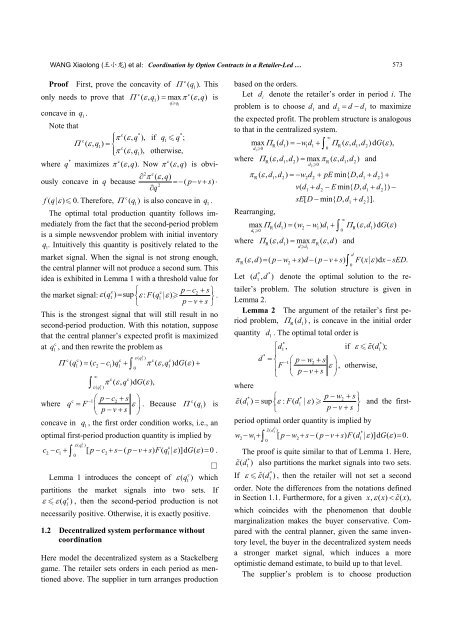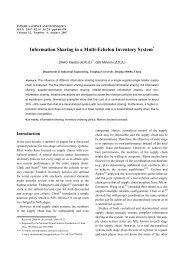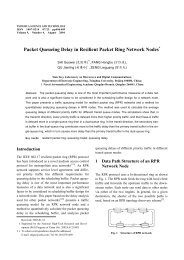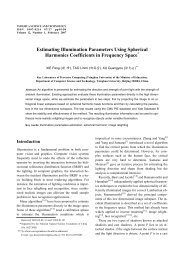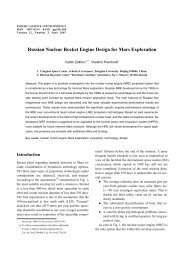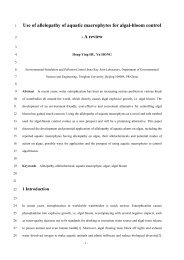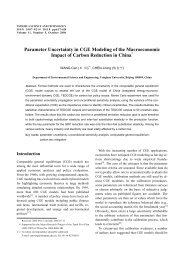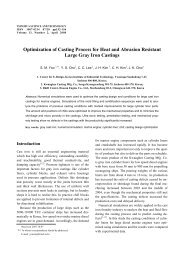Coordination by Option Contracts in a Retailer-Led Supply Chain with
Coordination by Option Contracts in a Retailer-Led Supply Chain with
Coordination by Option Contracts in a Retailer-Led Supply Chain with
You also want an ePaper? Increase the reach of your titles
YUMPU automatically turns print PDFs into web optimized ePapers that Google loves.
WANG Xiaolong (王小龙) et al:<strong>Coord<strong>in</strong>ation</strong> <strong>by</strong> <strong>Option</strong> <strong>Contracts</strong> <strong>in</strong> a <strong>Retailer</strong>-<strong>Led</strong> …<br />
c<br />
Proof First, prove the concavity of Π ( q1)<br />
. This<br />
c c<br />
only needs to prove that Π ( ε, q1) = max π ( ε,<br />
q)<br />
is<br />
qq1 concave <strong>in</strong> q 1 .<br />
Note that<br />
c * *<br />
⎧⎪ π ( ε,<br />
q ), if q c<br />
1 q ;<br />
Π ( ε,<br />
q1)<br />
= ⎨ c<br />
⎪⎩ π ( ε,<br />
q1),<br />
otherwise,<br />
*<br />
c c<br />
where q maximizes π ( ε , q).<br />
Now π ( ε , q)<br />
is obvi-<br />
2 c<br />
∂ π ( ε,<br />
q)<br />
ously concave <strong>in</strong> q because =−( p− v+ s)<br />
⋅<br />
2<br />
∂q<br />
c<br />
f( q| ε ) 0. Therefore, Π ( q1)<br />
is also concave <strong>in</strong> q 1 .<br />
The optimal total production quantity follows immediately<br />
from the fact that the second-period problem<br />
is a simple newsvendor problem <strong>with</strong> <strong>in</strong>itial <strong>in</strong>ventory<br />
q 1.<br />
Intuitively this quantity is positively related to the<br />
market signal. When the signal is not strong enough,<br />
the central planner will not produce a second sum. This<br />
idea is exhibited <strong>in</strong> Lemma 1 <strong>with</strong> a threshold value for<br />
c ⎧ c p− c2+ s<br />
the market signal: ε ( q1 ) = sup<br />
⎫<br />
⎨ε : Fq ( 1 | ε ) ⎬ .<br />
⎩<br />
p− v+ s ⎭<br />
This is the strongest signal that will still result <strong>in</strong> no<br />
second-period production. With this notation, suppose<br />
that the central planner’s expected profit is maximized<br />
at q , and then rewrite the problem as<br />
c<br />
1<br />
c c<br />
1 2 1<br />
c<br />
1<br />
c<br />
ε ( q1<br />
)<br />
∫ 0<br />
c c<br />
1<br />
∞<br />
c c<br />
∫ π ( ε, q )d G(<br />
ε),<br />
c<br />
ε ( q1<br />
)<br />
Π ( q ) = ( c − c ) q + π ( ε, q )d G(<br />
ε)<br />
+<br />
c 1 p c2 s<br />
where q F<br />
p v s ε<br />
− ⎛ − + ⎞<br />
= ⎜ ⎟ . Because<br />
⎝ − + ⎠<br />
c<br />
Π ( q1)<br />
is<br />
concave <strong>in</strong> q 1 , the first order condition works, i.e., an<br />
optimal first-period production quantity is implied <strong>by</strong><br />
c<br />
ε ( q1<br />
)<br />
c<br />
2 1<br />
0<br />
2 1<br />
∫<br />
c − c + [ p− c + s−( p− v+ s) F( q | ε)]d G(<br />
ε)<br />
= 0.<br />
□<br />
c<br />
Lemma 1 <strong>in</strong>troduces the concept of ε ( q1<br />
) which<br />
partitions the market signals <strong>in</strong>to two sets. If<br />
c<br />
ε ε(<br />
q1<br />
) , then the second-period production is not<br />
necessarily positive. Otherwise, it is exactly positive.<br />
1.2 Decentralized system performance <strong>with</strong>out<br />
coord<strong>in</strong>ation<br />
Here model the decentralized system as a Stackelberg<br />
game. The retailer sets orders <strong>in</strong> each period as mentioned<br />
above. The supplier <strong>in</strong> turn arranges production<br />
573<br />
based on the orders.<br />
Let d i denote the retailer’s order <strong>in</strong> period i. The<br />
problem is to choose d 1 and d2 = d − d1<br />
to maximize<br />
the expected profit. The problem structure is analogous<br />
to that <strong>in</strong> the centralized system.<br />
∞<br />
max ΠR( d1) =− wd 1 1+∫ ΠR( ε, d1, d2) d G(<br />
ε),<br />
d10<br />
0<br />
where ΠR( ε, d1, d2) = max πR( ε,<br />
d1, d2)<br />
and<br />
d20<br />
πR( ε , d1, d2) = − w2d2 + pEm<strong>in</strong>{ D, d1+ d2}<br />
+<br />
vd ( 1+ d2 − Em<strong>in</strong>{ Dd , 1+ d2})<br />
−<br />
sE[ D − m<strong>in</strong>{ D, d + d }].<br />
Rearrang<strong>in</strong>g,<br />
1 2<br />
max ΠR( d1) = ( w2 − w1) d1+∫ΠR( ε, d1) d G(<br />
ε)<br />
d10<br />
0<br />
where ΠR( ε, d1) = max πR( ε,<br />
d)<br />
and<br />
<br />
R 2<br />
d d1<br />
π ( ε, d) = ( p− w + s) d−( p− v+ s) F( x| ε)d<br />
x−sED. * *<br />
Let ( d1, d ) denote the optimal solution to the retailer’s<br />
problem. The solution structure is given <strong>in</strong><br />
Lemma 2.<br />
Lemma 2 The argument of the retailer’s first period<br />
problem, Π R( d1)<br />
, is concave <strong>in</strong> the <strong>in</strong>itial order<br />
quantity d 1 . The optimal total order is<br />
* *<br />
⎧d1,<br />
if ε ε(<br />
d1);<br />
* ⎪<br />
d = ⎨ −1<br />
⎛ p− w2+ s ⎞<br />
⎪F<br />
⎜ ε ⎟,<br />
otherwise,<br />
⎩ ⎝ p− v+ s ⎠<br />
where<br />
* ⎧ * p− w2+ s⎫<br />
ε( d1) = sup ⎨ε : F( d1<br />
| ε)<br />
⎬ and the first-<br />
⎩ p− v+ s ⎭<br />
period optimal order quantity is implied <strong>by</strong><br />
*<br />
ε ( d1<br />
)<br />
*<br />
2 1<br />
0<br />
2 1<br />
∫ <br />
w − w + [ p− w + s−( p− v+ s) F( d | ε)]d G(<br />
ε)<br />
= 0.<br />
The proof is quite similar to that of Lemma 1. Here,<br />
*<br />
ε ( d1<br />
) also partitions the market signals <strong>in</strong>to two sets.<br />
*<br />
If ε ε(<br />
d1<br />
) , then the retailer will not set a second<br />
order. Note the differences from the notations def<strong>in</strong>ed<br />
<strong>in</strong> Section 1.1. Furthermore, for a given x, ε ( x) < ε ( x)<br />
,<br />
which co<strong>in</strong>cides <strong>with</strong> the phenomenon that double<br />
marg<strong>in</strong>alization makes the buyer conservative. Compared<br />
<strong>with</strong> the central planner, given the same <strong>in</strong>ventory<br />
level, the buyer <strong>in</strong> the decentralized system needs<br />
a stronger market signal, which <strong>in</strong>duces a more<br />
optimistic demand estimate, to build up to that level.<br />
The supplier’s problem is to choose production<br />
∞<br />
∫<br />
0<br />
d


